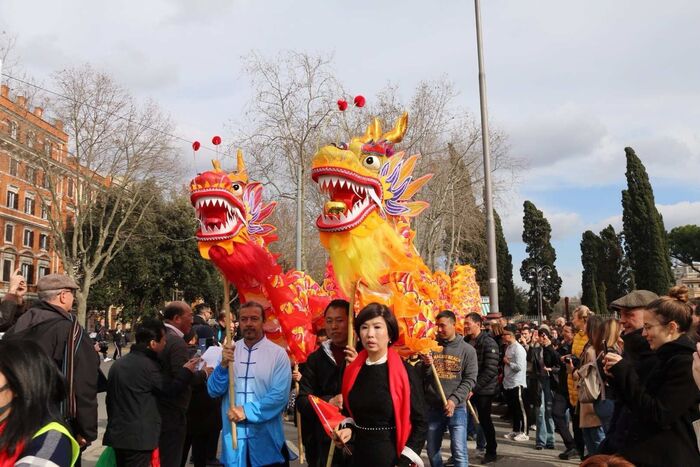New Year's Eve customs in Germany: From lead pouring to "Dinner for One"
Created: 12/26/2022, 2:30 p.m
The turn of the year is approaching and, like every year, it is also traditionally celebrated in Germany.
But where do the New Year's traditions actually come from and which ones still exist?
It's that time again: Christmas is over, many people's trees have already been decorated and good resolutions are being written.
The turn of the year is just around the corner and with it many traditions that are carried out like every year.
These include the fireworks, the festive meal, lucky charms, lead pouring and "Dinner for One".
But why actually?
With these New Year's Eve customs we Germans celebrate the arrival of the new year and that's where these traditions come from.
Story of New Year's Eve: The name comes from a pope
New Year's Eve has been celebrated for over 400 years.
Since the Gregorian calendar was introduced in 1582, a calendar year has ended on December 31st.
The turn of the year was given the nickname "New Year's Eve" by Pope Silvester I, who dedicated the day as the turn of the year during his lifetime, introduced Christianity as the state religion and after his death on December 31, 335 was named the New Year's festival.
A few traditions can still be derived from Pope Silvester, but the New Year in Germany is now celebrated in a somewhat unchristian way and with a spectacle.
Toasting at midnight and fireworks are traditionally part of New Year's Eve © CHROMORANGE/Imago
Food and drinks: That's what's on the table at the turn of the year
On December 31st, there is no feast served up like at Christmas, for example.
Nevertheless, the holiday is also celebrated with culinary delights.
The absolutely traditional dishes include "Berliner", also called "Krapfen" depending on the region, which are traditionally filled with jam.
However, other flavors have prevailed over the years and there are now Berliners with chocolate, caramel, eggnog or nut fillings and numerous glazes.
In some areas, a homemade donut for the celebrations is stuffed with mustard to annoy an unlucky guest.
It is no longer clear where the custom came from.
Speculations say that the little cakes were used as a reserve for the sparse Lent.
Raclette and fondue are just as popular as New Year's Eve dishes.
Because it's a reason to celebrate, there's of course a glass of sparkling wine at midnight on New Year's Eve. But during the celebrations beforehand, everyone can drink whatever they like.
However, since the New Year is usually celebrated outside, New Year's punch or Feuerzangenbowle are also classic drinks.
When toasting, they wish each other “Happy New Year”.
The exclamation comes from Latin and is said to bring good luck for the new year.
Rituals: fireworks, lead pouring and red underwear
Another tradition that has become an integral part of German New Year's Eve celebrations is the fireworks display.
Despite environmental and animal protection activism or fireworks bans during the corona pandemic, the preference to start the new year with lots of noise and sparks is valiant.
The origin of this lies with the old Germans, who said goodbye to the old year with a lot of noise 2000 years ago at the turn of the year.
At that time it was believed that drums and loud noises could drive away the evil spirits of the past year.
If you look at the good intentions and the liberating thought of putting a year behind you, not much has changed to this day.
The first real fireworks are said to have been in Germany in 1506.
The custom of detonating explosives at festivals
also read
You shouldn't wash towels and bed linen together: four reasons why you shouldn't
READ
Heating with wood: Three mistakes that almost everyone makes when lighting the stove
READ
Clean yellowed toilet seat: With four simple home remedies, it becomes nice and white again
READ
Clogged drain in the kitchen?
Three home remedies that now clean clogged pipes
READ
Energy-guzzling refrigerator: How to reduce your electricity consumption
READ
Fancy a voyage of discovery?
My space
Another, slightly less noisy, tradition on New Year's Eve is lead casting, which is now being replaced by wax casting due to lead's toxicity.
You melt the wax and drip it into cold water, creating shapes that are said to predict your fate in the new year.
It is no longer possible to say exactly where this tradition came from.
Researchers attribute it to both the ancient Greeks and the ancient Romans, whose civilization specialized in lead manufacturing and processing.
If you plan to find love in the new year, you should wear red underwear on New Year's Eve.
At least that is what a superstition that is particularly popular in southern Europe says: If a woman wears red – and preferably new – underwear at the turn of the year, she will find love in the new year and be rewarded with health, happiness and passion.
Where this superstition comes from is not exactly clear.
Some say it is attributed to navigator Marco Polo, who brought from China the custom that the color red represents luck and prosperity.
Others believe that red lingerie was worn as a symbol of good luck for the new year as early as ancient Rome.
"Dinner for One": The same procedure as every year
A tradition that has become established, although it has absolutely no superstitious background, is watching "Dinner for One" together.
The British sketch starring Freddie Frinton and May Warden hit theaters like a bomb in the 1960s and from then on was so popular that audiences wanted to see it again and again.
The NDR therefore decided in 1962 to record the 18-minute piece.
The clip was shown again and again on television and since 1972 it has been part of the regular evening program on New Year's Eve.
And if you fall asleep in front of the television after all the celebrations, you can lie there comfortably the next morning and watch the traditional New Year's concert of the Vienna Philharmonic.
Ten colorful houseplants that spread a good mood in winter
View photo gallery
Lucky charms: These mean horseshoes, ladybugs and chimney sweeps
New Year's Eve is not New Year's Eve if the decoration of lucky charms is missing.
Horseshoes, lucky pennies, chimney sweeps, four-leaf clovers and lucky pigs can be found everywhere at this time of year, decorate the New Year's department in the supermarket and decorate donuts and donuts at the bakery counter.
Unlike many other traditions, the origin of the horseshoe superstition is well known, as it can be traced back to Pope Sylvester.
An old story about the priest says that he once rode from Rome to Trier during his lifetime, and his horse is said to have lost a horseshoe.
This allegedly happened in Hausen, which is now a district of Mayen in the Eifel.
In memory of this story, it is still a tradition in Hausen that a pastor leads a procession on horseback around the church on New Year's Eve and then blesses the animals and riders.
The horseshoe is also said to bring luck and protection for house and yard.
The lucky pig, on the other hand, comes from a Germanic custom.
For them, the boar was sacred and meant wealth and prosperity.
The ladybugs, which always like to sit on the four-leaf clover in New Year's Eve decorations, are considered messengers of the Holy Virgin Mary and are therefore a Christian tradition.
They are supposed to protect the sick and children.
The chimney sweep is said to bring good luck all year round, but on New Year's Eve chimney sweeps used to go through the streets and wished people a "Happy New Year".
If you also have a lucky penny or cent in your pocket on New Year's Eve, you should be blessed with wealth next year.
You can find everything to do with household and garden tips in the regular living newsletter from our partner Merkur.de.
Sign up here!
New Year's Eve in different regions: from north to south
New Year's Eve customs are therefore mostly traditions that have been naturalized for centuries or millennia.
Nevertheless, some details in the New Year's celebrations differ from region to region in Germany.
In Bavaria, for example, the Rauhnächte are celebrated according to old Christian tradition, which are usually celebrated from Christmas to Epiphany.
During this time, the demons and evil spirits of the previous year are driven out with incense at night.
In addition, in some Bavarian and Austrian villages, the children go through the villages on New Year's Day to greet the new year with an annually changing proclamation.
This custom is also called the "Crying of the New Year".
In the north, too, people celebrate the time between the years with their very own traditions.
In Hamburg, for example, it has been a tradition for centuries not to do any laundry between Christmas and January 6th, because the clothes on the line used to be reminiscent of shrouds and people did not want to have such negative thoughts that should bring bad luck at the turn of the year.
In Westphalia there is also the "New Year's hammering" in traditional, old communities.
You gather at a blacksmith's who, together with his journeymen, literally "hammers out" the old year on an anvil.








